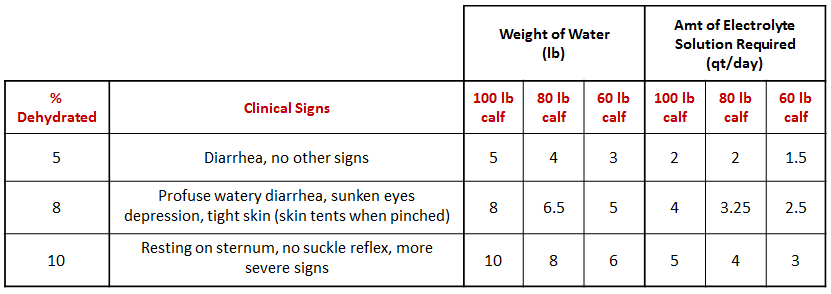If I were to pick the conversation I have most often with calf raisers, it would be about feeding electrolytes: how much and how often to feed oral electrolytes to scouring calves. Confusion often arises when trying to apply package instructions. Feeding directions are limited and typically describe a narrow set of applications. They often read like cookbook instructions which simply don’t – and can’t – describe all situations.
Instructions for feeding electrolytes may run counter to personal intentions. Some say to use the product in place of milk feedings, others say to feed in addition to normal milk feedings. Add to milk; don’t feed in milk. Feed two quarts twice a day, once a day, feed for three days — what if the calf still has diarrhea?
To begin with, it helps to have a good idea or a sense of what a scouring calf needs. A calf with diarrhea and no other visible signs of dehydration is about 4-5% dehydrated. This means a 100 pound calf needs about 4-5 pounds of water to get back to normal.
100 pound calf that is 4% dehydrated: 100 pounds x 0.04 = 4 pounds water loss
100 pound calf that is 5% dehydrated: 100 pounds x 0.05 = 5 pounds water loss
(easy to calculate for a calf of any weight)
Since a gallon of water weighs about 8 pounds, a quart of water weighs 2 pounds. Therefore, our 100 pound calf needs 4-5 pounds of water, or about 2 quarts of electrolyte solution. This is the amount of electrolyte solution that would be administered each day to this calf until it improves.
Keep in mind that this calf became 4-5% dehydrated while it was drinking its regular milk/milk replacer feedings. This means the calf needs the 2 quarts of electrolyte solution in addition to the liquid nutrition it normally receives, not instead of.
If the calf shows additional signs, such as sunken eyes, depression, tight skin (skin tents when pinched), or water-like diarrhea, it may be 7-8% dehydrated and in need of additional electrolyte feeding. The table below summarizes daily electrolyte requirements for 100, 80 and 60 pound calves.
Guidelines for Feeding Electrolytes to Dehydrated Calves

A calf with diarrhea and no signs of advanced dehydration requires treatment at the 5% dehydration level. Calves with water-like diarrhea or other clinical signs of advanced dehydration are likely losing water at a higher rate and would benefit more from treatment at the 8% dehydration level. Calves that are 10% dehydrated may not be good candidates for oral rehydration therapy, and usually require other methods of administering supportive fluids such as intravenous administration.
______________________________
Note:
Some organisms damage intestinal villi while other cause hypersecretion of water into the digestive tract. These situations can lead to decreased absorption of fluids. If, for example, only 70% of the electrolyte solution is absorbed, the other 30% will pass through the calf, increasing fecal water loss. This makes the diarrhea appear to be worsening even though treatment is effective. In these situations, the frequency of treatment should be increased. Based on the table, you treat calves with water-like diarrhea at the 8% dehydration level.
Also, keep an eye on the front end of calf. If the calf is alert, active and wanting to eat, you are on the right track. Balance what’s happening at this end of the calf with what you see at the other end.
______________________________
Once you have a good idea of what the calf needs, you can administer oral electrolytes accordingly. Be sure to read the product label to understand what the product is and to understand how to mix the product and how the manufacturer intends/suggests that it should be used.
That won’t necessarily end all conflicts, but at least now you’ll be able to decide how to use the product or whether you should choose another one. If the label tells you to mix with water and feed in place of regular milk/milk replacer feedings or to add directly to the milk or milk replacer, you may choose to do that, but what are you going to do to correct the calf’s water loss? Correcting dehydration is what electrolyte therapy is all about.
